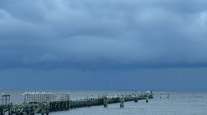Washington State Sees More Flooding as Next Storm Approaches

[Stay on top of transportation news: Get TTNews in your inbox.]
Localized flooding in Washington state from another in a series of rainstorms doesn’t appear to be as severe as an extreme weather flooding event earlier in the month.
People in the small communities of Sumas and Everson in northwest Washington had been asked to evacuate voluntarily Nov. 27. Both towns near the Canadian border previously saw hundreds evacuated and severe flooding from days of rain that caused an estimated $50 million in damage to Whatcom County.
In Sumas, officials used the flood siren at around 9 a.m. Nov. 29 and urged people to shelter in place as water bypassed the Cherry Street bridge and then spread through town, albeit somewhat slowly, according to a post on Facebook.
On Nov. 29, Sumas officials said there was a lot of water around town, but that the water level had started to slowly drop.
Scenes of yet more flooding in Sumas, Washington (courtesy @wsdot)
Flooding coverage continues with @martinmacmahon at 11:03a on @CityNewsVAN
Find updates on our coverage here: https://t.co/jWKF1Z1ZUx pic.twitter.com/3Na1hoz84W — Peter Wagner (@peterjontheair) November 29, 2021
“We believe that this will continue to happen throughout the rest of the day,” officials said on Facebook.
On Nov. 28, Everson Mayor John Perry posted on Facebook that water levels on a main road through town were “slowly receding” and that Nooksack River levels were dropping.
“It appears that we are through the worst of it for the Everson/Nooksack area,” Perry wrote.
Many local roads in the area and around Bellingham were closed Nov. 28-29 because of water over the roadway and some schools in the region kept students from classes as a safety precaution. A landslide Nov. 28 blocked part of northbound Interstate 5 south of Bellingham and officials said an increased threat of landslides will remain for several days.

For Veterans Day, host and Navy veteran Michael Freeze sits down with Army veterans James Rogers, owner of Spartan Direct Trucking Co. and 2020 Transport Topics Trucking's Frontline Hero, and John Baxter, equipment columnist. Hear a snippet above, and get the full program by going to RoadSigns.TTNews.com.
Bellingham city officials said rainwater exceeded pumping capacity at times Nov. 28 resulting in an overflow that discharged about 9 million gallons of sewage water into Bellingham Bay.
“The impacts to water quality as the result of the need for sewage overflow are expected to be minimal,” a city news release said.
Downstream in Ferndale, Mayor Greg Hansen told The Bellingham Herald several homes in low-lying areas near the river have seen flooding in latest storm, but the swollen river remains below its levee, he said.
“It definitely has filled the floodways,” Hansen said.
More rain was forecast for Nov. 30, the latest deluge from atmospheric rivers — huge plumes of moisture extending over the Pacific and into the Northwest.
Forecasters say the rainfall totals should be less than previous storms, with up to 2 inches expected in northwest Washington and up to 4 inches in the Olympic and Cascade Mountains.
2 drivers have second thoughts crossing flooded Hannegan Rd. south of Lynden and put it in reverse Sunday. @luluramadan reports on heavy rains and rising river waters bringing more flooding to saturated northwest Washington communities https://t.co/fthze8Awru via @seattletimes pic.twitter.com/z8PzRG0IVI — Ken Lambert (@SeaTimesFotoKen) November 29, 2021
With 18.91 inches of rain recorded at Seattle-Tacoma International Airport between Sept. 1 and Nov. 28, and the impending rain Nov. 30 could have the wettest early fall on record, The Seattle Times reported.
The second wettest September-through-November period in Seattle was recorded in 2006, with 18.61 inches of rain, according to the National Weather Service in Seattle.
“It’s the wettest early fall we’ve had in Seattle in a long, long time,” weather service meteorologist Kirby Cook said Nov. 29. “And in some areas, like Bellingham, it will be the wettest November on record.”
Ferndale’s mayor said the city’s Emergency Operations Center would remain open through the end of the week because of the anticipated Nov. 30 storm.
“We know we have significant rain coming and we are anticipating another river crest,” Hansen said. “We’re going to continue to stay in a heightened alert status.”
Want more news? Listen to today's daily briefing below or go here for more info:




